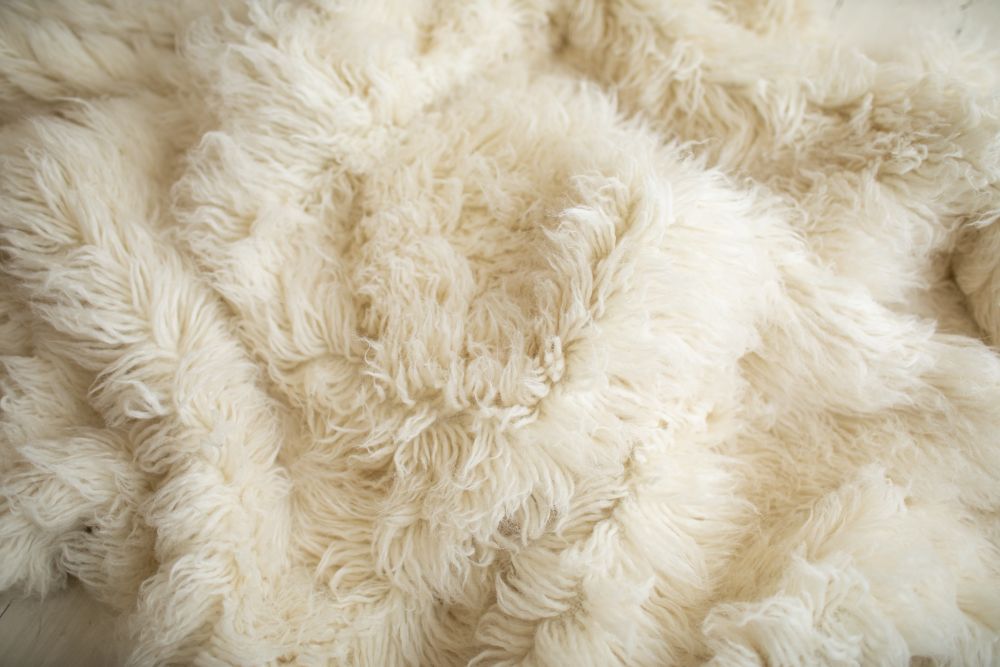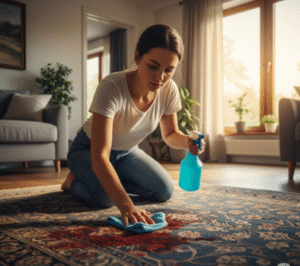Rug Journal strives to help you care for your rugs but always recommends professional services for the best results. We are not responsible for any damage to your rugs.
The word “flokati” evokes images of luxurious, shaggy rugs that bring warmth and texture to any space. But did you know that these iconic rugs have a history that stretches back thousands of years? From their humble beginnings in the mountains of Greece to their modern-day revival in chic interiors, flokati rugs are a testament to timeless craftsmanship and enduring appeal.
The Origins of the Flokati Rug

The term “flokati” originates from the Aromanian word “floc,” derived from the Latin “floccus,” meaning “flock” or “tuft.” This perfectly describes the rug’s signature shaggy texture. Another related term, βελέντζα (vel’endza), has roots in Turkish and possibly Albanian, reflecting the cultural exchanges that shaped the rug’s history. The word “flokati” first appeared in English in 1967, but its story begins much earlier.
A History Steeped in Tradition
✦ Ancient Beginnings
Flokati rugs have a rich history that dates back to ancient Greece. Legend has it that Alexander the Great used flokati rugs to insulate his tents during his conquests in Egypt and Asia Minor. Their thick, woolen pile provided warmth and comfort in harsh climates, making them indispensable for soldiers and travelers.
✦ Shepherd Craftsmanship
The tradition of flokati rug-making began with shepherds in the Pindus Mountains of Greece. These skilled artisans wove rugs from the wool of their flocks, creating durable and versatile textiles. Initially, flokati rugs were not just floor coverings—they were used as bedding, wall hangings, and even saddle blankets for horses and donkeys.
✦ The Waterfall Technique
One of the most fascinating aspects of flokati production is the “waterfall process.” Shepherds discovered that washing the woven rugs in fast-flowing mountain streams tightened the rug’s backing and dramatically increased the loftiness of the pile. This unique method remains a hallmark of authentic flokati rugs to this day.
Cultural Significance
✦ Bridal Dowries
In regions like Trikala, flokati rugs were often included in bridal dowries. These rugs were sometimes adorned with intricate borders, reflecting the bride’s style and adding a touch of elegance to her new home.
✦ Versatility
Flokati rugs were prized for their versatility. Beyond their use as floor coverings, they served as insulation for walls and beds, providing warmth during cold winters. Their durability and practicality made them a staple in Greek households.
The 20th-Century Renaissance
✦ Jackie Kennedy Onassis’ Influence
The global popularity of flokati rugs surged in the 1960s and 70s, thanks in part to Jackie Kennedy Onassis. After her marriage to Aristotle Onassis, she decorated their private Greek island, Skorpios, with flokati rugs. Their luxurious texture and natural elegance captured the imagination of designers and homeowners worldwide.
✦ The Rise of Synthetic Shag
The success of flokati rugs inspired the mass production of synthetic shag carpets made from materials like polyester and acrylic. While these cheaper alternatives gained popularity, they lacked the authenticity and craftsmanship of genuine flokati rugs. By the 1980s, the trend had waned, but flokati rugs symbolized timeless elegance.
✦ Modern Revival
In recent decades, interest in authentic flokati rugs has been resurgent. Designers and homeowners are drawn to their handcrafted quality and natural beauty, making them a favorite for boho-chic, minimalist, and rustic interiors.
Modern Flokati Production
✦ Maintaining Tradition
Today, authentic flokati rugs are still produced in Greece, often using New Zealand wool for their softness and durability. While modern production methods involve automated looms, the crucial waterfall process remains an integral part of the craft.
✦ Quality Standards
To preserve their authenticity, the term “flokati” is legally protected in Greece. Only rugs made from 100% sheep’s wool and produced within the country can bear the official flokati label. This ensures that each rug meets the highest standards of quality and craftsmanship.
Caring for Your Flokati Rug
1. Regular Maintenance
- Vacuuming: Use a vacuum with a rotating brush attachment on low power to remove dust and dirt without damaging the delicate fibers.
- Rotation: Rotate your rug periodically to ensure even wear and prevent fading in specific areas.
2. Deep Cleaning
- Professional Cleaning: For deep cleaning, consult a rug specialist who understands the unique needs of Flokati rugs.
- Spot Cleaning: For minor spills, blot the area immediately with a clean, absorbent cloth. Avoid rubbing, as this can spread the stain and damage the pile.
3. Protecting Your Rug
- Sunlight: Keep your Flokati rug out of direct sunlight to prevent fading and fiber damage.
- Fluffing: If the pile becomes matted, gently brush it with a soft-bristled brush or use a pet grooming tool to restore its loftiness.
4. Reviving a Matted Flokati Rug
Over time, the pile of a flokati rug may flatten or mat. Here’s how to bring it back to life:
- Gentle Brushing: Use a soft-bristled brush to gently lift the fibers.
- Fluffing Technique: Pull on the pile in different directions to encourage it to stand up again.
Why Choose a Flokati Rug?
Flokati rugs are more than just floor coverings—they are works of art with a rich cultural heritage. Their natural texture and timeless elegance make them a versatile addition to any home. Whether you’re drawn to their history, their luxurious feel, or their ability to transform a space, a flokati rug is an investment in both style and comfort.
Beyond Flokati: The World of Shag Rugs
While flokati rugs are iconic, they are not the only shaggy rugs with historical significance. From Moroccan shag rugs to Persian pile carpets, the world of shag rugs is diverse and fascinating. Each style brings its unique texture and story, offering endless possibilities for interior design. Visit RugJournal for more inspiration
Conclusion
From the tents of Alexander the Great to the living rooms of modern design enthusiasts, flokati rugs have stood the test of time. Their rich history, unparalleled craftsmanship, and timeless appeal make them a beloved choice for creating cozy, inviting spaces. Whether you choose an authentic Greek flokati or a modern interpretation, these rugs are sure to add warmth and character to your home.
A Simple Guide to Cleaning and Caring for Flokati Rugs
Flokati rugs are known for their soft, luxurious feel and timeless beauty. However, keeping them looking their best requires proper care and cleaning. In this guide, we’ll walk you through easy-to-follow steps and tips to help you clean and maintain your Flokati rug, ensuring it stays soft, fluffy, and beautiful for years.
Understanding Flokati Rugs and Their Cleaning Needs
Flokati rugs are handmade wool rugs from Greece, famous for their long, thick pile that feels cozy and inviting. Because of their unique texture and material, they can easily collect dust, dirt, and stains over time. Regular cleaning is essential to keep them looking great and to extend their lifespan.
Why Flokati Rugs Get Dirty
- Thick Pile: The long, dense fibers of Flokati rugs trap dust, dirt, and debris deep within, making it harder to see the dirt on the surface.
- Foot Traffic: Rugs in high-traffic areas, like living rooms or entryways, tend to get dirtier faster. Dirt, oils, and residues from shoes or bare feet can build up over time.
- Wool Absorbs Spills: Wool is naturally absorbent, so spills and stains can soak into the fibers quickly. It’s important to clean up spills right away to avoid permanent stains.
- Pet Hair and Dander: If you have pets, their hair and dander can get stuck in the rug’s fibers, making it dirtier and requiring more frequent cleaning.
- Dust and Pollen: Even indoor air can carry dust, pollen, and other particles that settle into the rug over time.
Step-by-Step Cleaning Process
Follow these simple steps to clean your Flokati rug:
✦ Preparation: Take the rug outside to an open area, if possible. If you can’t go outside, lay down a tarp or large sheet to catch any dirt or debris.
✦ Shake and Beat the Rug: Hang the rug over a sturdy clothesline or railing and shake it gently to remove loose dirt. Use a soft rug beater to gently beat the rug from one end to the other. This helps remove dirt trapped deep in the fibers.
✦ Vacuum the Rug: Use a vacuum cleaner with a brush attachment or a handheld vacuum in a low-power setting. Slowly vacuum the rug in the direction of the pile. Avoid using high suction or a beater bar, as these can damage the wool fibers.
✦ Spot Clean Stains: If you spill something, act quickly! Blot the stain with a clean, white cloth—don’t rub, as this can spread the stain. Mix a small amount of mild detergent with water and test it on a hidden area of the rug to make sure it doesn’t cause damage. If it’s safe, gently dab the stain with the solution using a soft brush or cloth. Rinse with clean water and blot dry with a towel.
✦ Hand Wash the Rug: Fill a bathtub or large basin with lukewarm water and add a wool-friendly detergent. Submerge the rug and gently move it around with your hands to clean the fibers. Avoid scraping or rubbing too hard, as this can damage the rug. Let the rug soak for a few minutes to loosen dirt, then gently massage the fibers.
✦ Rinse and Dry: Rinse the rug thoroughly with clean water to remove all soap. Gently press the rug to remove excess water—don’t wring or twist it. Lay the rug flat to dry in a shaded, well-ventilated area. Avoid direct sunlight, as it can fade the colors and damage the wool.
Tips for Keeping Your Flokati Rug in Great Condition
- Vacuum Regularly: Vacuum your rug at least once a week to prevent dirt and dust from building up.
- Use a Rug Pad: Place a rug pad underneath to prevent slipping and reduce wear on the rug.
- Rotate the Rug: Turn the rug occasionally to ensure even wear and fading.
Act Fast on Spills: Clean up spills immediately to prevent stains from setting in
Do’s and Don’ts for Cleaning Flokati Rugs
Do’s
- Vacuum regularly with a brush attachment or handheld vacuum on a low setting.
- Blot stains immediately with a clean cloth and mild detergent.
- Hand wash with lukewarm water and wool-friendly detergent.
- Dry the rug flat in a shaded, well-ventilated area.
- Test cleaning solutions on a small, hidden area first.
Don’ts
- Don’t use harsh chemicals, bleach, or strong cleaners.
- Don’t scrub or rub the rug aggressively.
- Don’t expose the rug to direct sunlight or high heat while drying.
- Don’t wring or twist the rug to remove water.
- Don’t handle the rug roughly, as this can damage the fibers.
Conclusion
Cleaning and caring for a Flokati rug doesn’t have to be complicated. By following these simple steps and tips, you can keep your rug soft, fluffy, and beautiful for years to come. With a little attention and care, your Flokati rug will continue to add warmth and elegance to your home. Contact us for more tips









